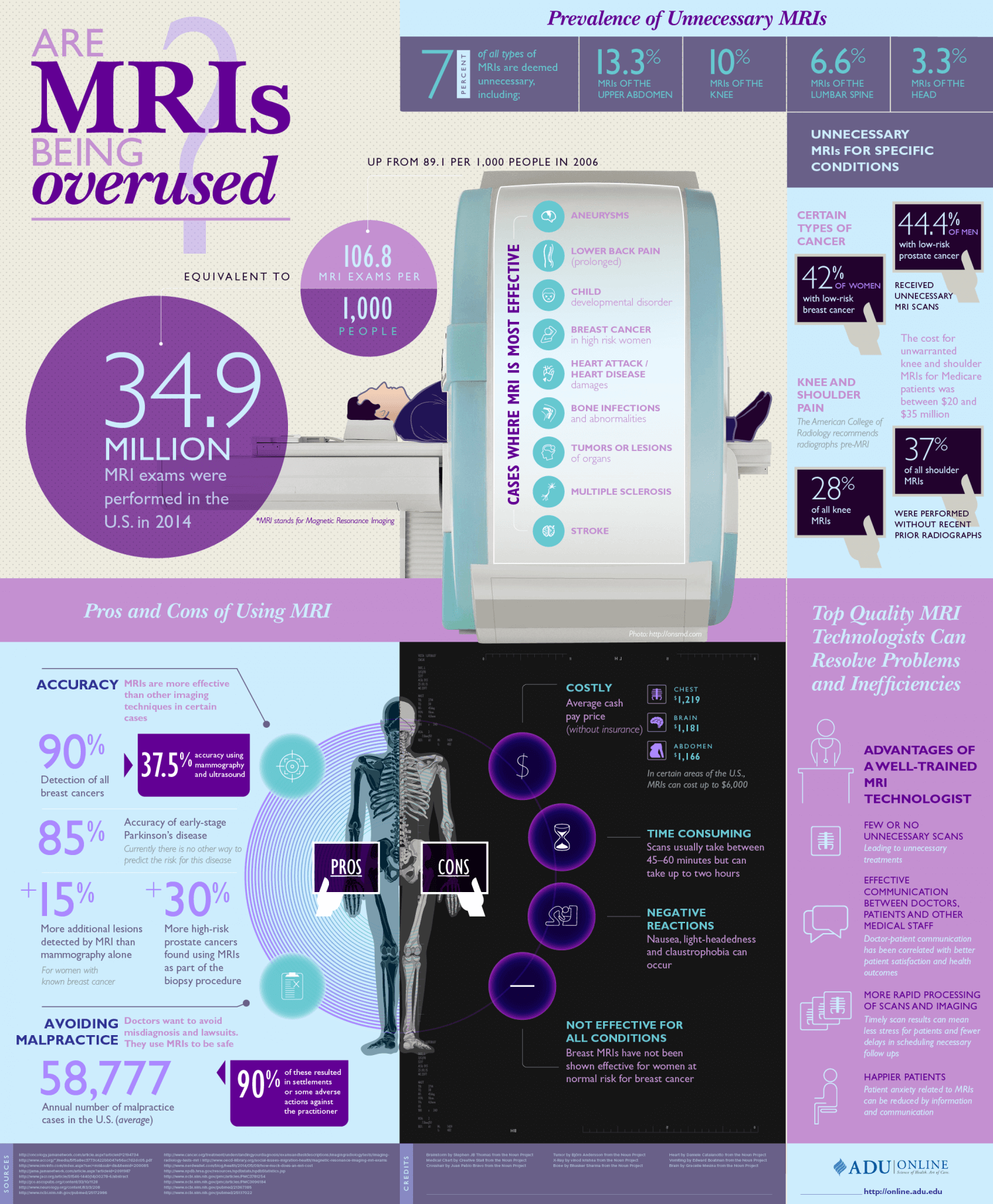- AdventHealth University

Magnetic Resonance Imaging, or MRI, exams are frequently prescribed by doctors across the U.S. for a variety of reasons, some legitimate but most unwarranted. There has long been confusion among patients wondering if they need one of these highly expensive exams and more often than not MRIs are being prescribed for specific medical conditions that do not really require this high-tech imagining exam placing a large financial strain on insurance companies and consumers alike.
To learn more about MRIs and their overuse in the U.S., checkout the infographic below created by AHU Online’s Bachelor of Science in Imaging Sciences.
Doctors overuse MRIs
More than 34 million MRI exams were performed in the U.S. in 2014. This is the equivalent to about 106 of these MRI exams per 1,000 people. While doctors assert that MRI exams are relatively safe, critics decry many health officials for not considering the down side of these highly expensive tests. The critics worry about millions of “needless” MRI exams at a time when the national health insurance system is already overtaxed and too expensive for customers.
Simply put, an MRI costs thousands of dollars, including high health insurance co-pays for patients who receive these exams.
What is an MRI, and why is it prescribed?
The AMA states that MRI exams are “widely used in hospitals” today for “more detailed” medical diagnosis and to gauge the staging of certain diseases that plague the head and other body parts. While doctors state that it is better to be “safe than sorry,” the jury is still out on why millions of patients are being exposed to an MRI’s dangerous ionizing radiation. MRI exams require the use of powerful scanners for creating radio waves and magnetic fields to identify “images” of the body. In turn, there is real concern in certain medical circles as to the “real need” of such high-tech radiology to investigate such things as a sore shoulder or tingling limbs.
MRI graph details unnecessary exams
It is estimated that 7% of MRIs are deemed “unnecessary”, with the most overprescribed MRI exams including those for specific health conditions, such as certain types of cancer and knee and shoulder pain. These procedures, on average, cost Medicare patients “between $20 and $35 million.”
Applications for MRI diagnostics
There are many good reasons to accept a doctor’s recommendation for an MRI exam, states an AMA white paper on the wide range of applications for this exam in modern medical diagnosis. While the AMA stats that an MRI is “generally safe,” there are numerous downsides. For instance, many people still think an MRI scanner uses harmful ionizing radiation. The AMA states clearly on its website that other than being time-consuming, expensive and claustrophobia fears in some patients, today’s MRI technology “does not use any ionizing radiation.”
A look inside the body
At the same time, there are many proven applications for MRI exams when it comes to allowing doctors a “better view” about what is going on inside their patient’s body. This view from the AMA website is coupled with the simple fact that there are thousands of MRI scanners being used in hospitals nationwide today. A doctor commented online about “why have these expensive MRI machines and not use them?” In turn, there were patients sharing their medical bill woes that included some who questioned “unnecessary MRIs?”
Moreover, there are patients who simply do not like the fact that MRI scanners use a powerful radio transmitter to generate its “electromagnetic field.” A patient shared on Facebook how she feared her body would “somehow absorb the MRI energy,” while another patient said a recent MRI “burnt tattoos” on his body.
Meanwhile, there are doctors who prefer a computed tomography (CT) scan to an expensive MRI exam simply because magnetic resonance imaging is very expensive today. A typical MRI exam can result in a patient having to pay upwards of hundreds of dollars as part of required insurance co-pays.
Still, there are many different types of health insurance that cover most of an MRI exam cost and doctors know this detail when prescribing this high-tech scan for better views of the body.


